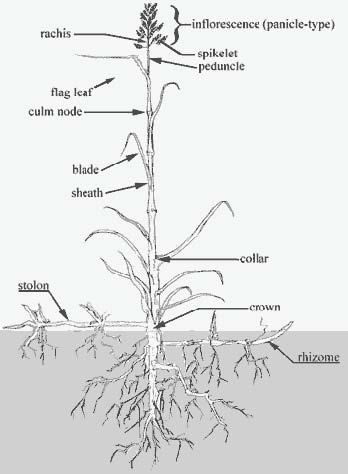Author: Sam Angima
Publish Date: Spring 2007
Forages and all green plants require moisture, nutrients, heat, and light for growth. To make hay, you need good nutrition to maximize on productivity and quality of the final product. You might want to treat hay fields and pasture fields differently in terms of when you apply fertilizers especially nitrogen even when soil test results are the same. To see how this works fi rst let us look at the grass plant. In spring, all perennial grasses grow from the crown that developed the previous year. Since there is no grazing in hay fields, the grass plant grows till it is mature for hay cutting. When there isn’t enough nutrition, you may end up with just one plant per crown and several weeds, however, when you supply plant nutrients at the proper time, the crown develops new tillers that fill up the space and hence gives you more hay at harvest time. Manipulating this nutrition the right way will maximize on hay produced.Initiation of plant growth in spring is regulated by temperature and light. Phosphorus and potassium that form half of the macronutrients needed for plants aid forages in new root development, building of new cell walls, energy metabolism & conversion, and development of new enzyme systems. These two nutrients should be applied as per the soil test results whenever it is physically possible (with all our winter rains) to go out in the field. Sulfur and boron should be applied in the spring if deficient.
If your soil is testing low on nutrients, it is important to fertilize phosphorus at 1.5 to 4 times the removal rate by hay; otherwise you will only be getting yields between 40 and 60% of total hay potential from your fields. Hay generally removes between 8-16 lbs P2O5/acre for one ton of hay (depending on your soil type). Optimal rates of phosphorus also increase leaf content of magnesium and calcium further enhancing photosynthesis and the quality of hay. Nitrogen use efficiency is also significantly increased by P fertilization. Optimal soil phosphorus level in your soil should be about 46lbs/acre. Potassium on the other hand should be applied at the removal rate.
Nitrogen, however, requires some timing and proper manipulations to get good yields and reduce losses. This is because nitrogen serves two important functions. These are to manipulate population (increasing tiller numbers) and to supply the nutritional needs of the crop to produce protein. It should be noted here that small amounts of nitrogen will increase early growth but when nitrogen is depleted, the resultant hay will be low in proteins (measured as total digestible nutrients – TDN). So how much nitrogen should you apply and when should you apply it? I highly recommend a soil test since there are many different soils in Oregon. Any one figure for one region will be misleading to other areas. Timing wise, for the Pacific Northwest, we use the T-Sum 200 guidelines that use cumulative temperature measurements. The T stands for temperature, and 200 accumulated heat necessary for grass growth to begin on the basis of plant physiology. The OSU calculator found here gives you current cumulative temperatures around the state for your area. For details on how to individually calculate T-Sum 200, get the OSU guide EM 8852 here. Scroll to page 4-5 and follow the procedure outlined.
After applying nitrogen at T-Sum 200, it takes anywhere between 1-2 weeks for plants to start responding giving a flush of growth. At this point, nutrients stored in the root system are made available for tiller development and growth. I would recommend applying only a quarter to half of the recommended nitrogen at this time because of the possibility of leaching as plant growth is still restricted. Depending on your location, you may then apply the second half of nitrogen 30-50 days later to reinvigorate and flush up all tillers that have so far developed. This also coincides with warmer weather that fully gives the plant the opportunity to grow into healthy hay plants.Harvesting of hay should ideally be done at boot stage. As grass hay matures, forage quality drops rapidly. Research has shown that crude protein content declines rapidly between boot & mature seed stages. Crude protein levels in well fertilized hay harvested at early heading, range from 10 to 18%, but drop rapidly after heading to about 8%. Decreases in crude protein levels by as much as ½ % per day after heading have been recorded. In Oregon, it is sometimes impossible to harvest hay due to wet weather but any break in the weather that gives you a chance to harvest at or near this physiological period will ensure good quality hay. After harvesting and before selling or feeding your hay, it is a good idea to run a forage test to get nutrient composition of what you harvested. Forage testing is also recommended even for those who buy hay to feed their livestock. Laboratories that perform hay testing for Oregon can be found here. To interpret your hay test results consult Oregon State University website for Hay testing terminologies and meanings here.


